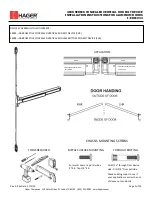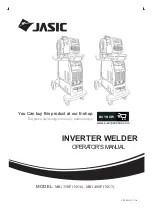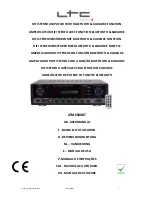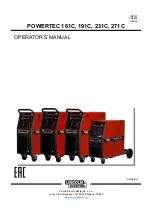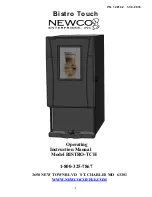
SECTION 3
OPERATION
13
E.
Fault Light.
Will glow red under the following
conditions and operations will come to a complete
stop:
1.
When duty cycle has been exceeded. The
duty cycles of this unit are 40% at rated output
current of 50 amperes, 60% at rated output
current of 40 amperes, and 100% at rated
output current of 30 amperes. Duty cycle is
based on a 10 minute cycle; therefore, at 40%
duty cycle, the unit can operate up to 4 minutes
and then must be allowed to cool down for the
next 6 minutes; at 60% duty cycle, the unit can
operate up to 6 minutes and then must be
allowed to cool down for the next 4 minutes; at
100% duty cycle, the unit can operate continu-
ously.
2.
When input voltage is outside the range of 150
to 270 volts.
3.3 CUTTING WITH THE PT-27
Use the following procedures to cut with the PT-27 torch
(Figure 3-4).
A.
Hold the torch approximately 1/8 inch above the
work and tilted at about 15 - 30°. This reduces the
chance of spatter entering the torch. If the PT-27's
standoff tool is being used, set the standoff at 1/
16 inch for materials less than 1/4-inch thick and at
3/16 inch for those over 1/4-inch thick.
B.
Depress the torch switch. Air should flow from the
torch and the high frequency should energize.
C.
Two seconds after depressing the torch switch,
the pilot arc should start. The main arc should
immediately follow, allowing the cut to begin. (If
using the LOCK-IN mode, torch switch may be
released after establishing the cutting arc.)
D.
After starting the cut, the torch should be main-
tained at a 5-15° forward angle (Figure 3-2). This
angle is especially useful in helping to create a
"drop" cut. When not using the standoff guide, the
nozzle should be held approximately 1/8 inch from
the work.
E.
When ending a cut, the torch switch should be
released (press and release if using LOCK-IN
mode) and lifted off the workpiece just before the
end of the cut to minimize double-arcing. This is
to prevent the high frequency from reigniting after
cutting arc extinguishes and causing damage to
the nozzle.
3.1 OPERATION
ELECTRIC SHOCK can kill.
• Do NOT operate the unit with the cover removed.
• Do NOT apply power to the unit while holding or
carrying the unit.
• Do NOT touch any torch parts forward of the torch
handle (nozzle, heat shield, electrode, etc.) with
power switch on.
ARC RAYS can burn eyes and skin;
NOISE can damage hearing.
• Wear welding helmet with No. 6 or 7 lens shade.
• Wear eye, ear, and body protection.
Position the PCM-750i at least 10 feet (3 meters) from
the cutting area. Sparks and hot slag from the cut-
ting operation can damage the unit.
3.2 PCM-750i CONTROLS (FIGURE 3-1)
A.
Power Switch (located on rear panel).
When
placed in ON position, the green pilot light will glow
indicating control circuit is energized and the cool-
ing fan will run.
B.
Output Current Control.
Adjustable from 10 to
50 amperes to suit cutting conditions.
C.
Air Check Switch.
When placed in ON position,
air filter-regulator can be adjusted to desired pres-
sure (65-75 psig) before cutting operations. Allow
air to flow for a few minutes. This should remove
any condensation that may have accumulated
during shutdown period. Be sure to place switch
in OFF position before starting cutting operations.
D.
Lock-In Switch.
When placed in ON position,
permits releasing torch switch button after cutting
arc has been initiated. To extinguish arc at end of
cut, press and release torch switch button again or
pull torch away from work. When placed in OFF
position, torch switch must be held closely by the
operator during the entire cutting operation and
then released at the end of cut.
Содержание PCM-750i
Страница 25: ...25 Figure 5 1 PCM 750i Series A Schematic Diagram 460 V 3 Phase Input D 35511 A ...
Страница 26: ...26 Figure 5 2 PCM 750i Series A Wiring Diagram 460 V 3 Phase Input D 35510 A ...
Страница 27: ...27 Figure 5 3 PCM 750i Series A Schematic Diagram 230 V 1 Phase Input D 35507 A ...
Страница 28: ...28 Figure 5 4 PCM 750i Series A Wiring Diagram 230 V 1 Phase Input D 35506 A ...





























